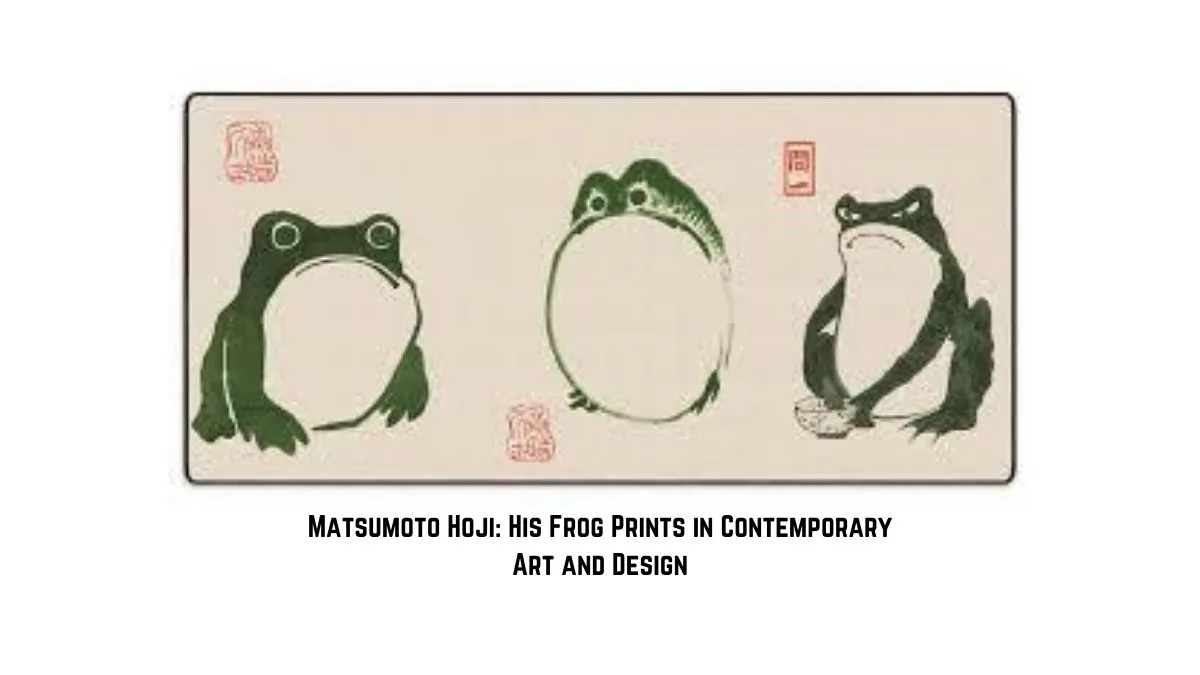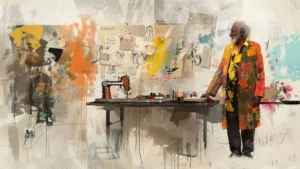GENERAL
Matsumoto Hoji: His Frog Prints in Contemporary Art and Design

Matsumoto Hoji’s frog prints captivate both art lovers and design enthusiasts. His work, rooted in Japanese tradition, continues to shape contemporary aesthetics. But why? His prints blend simplicity with deep symbolism, making them timeless. Whether in modern interiors or digital art, his unique style remains relevant. Collectors chase his prints, while new artists draw inspiration from his techniques. The question isn’t just about artistic merit—it’s about emotional connection. Matsumoto Hoji understood visual storytelling like few others. His frog prints tell tales of nature, life, and fleeting moments. That’s why his work refuses to fade from cultural consciousness.
Who Was Matsumoto Hoji?
Hoji Matsumoto established himself as both a visionary artist and a leader in Japanese art. The artistic environment of Japan formed the unique approach that defined Matsumoto Hoji’s journey. During his time, which marked important developments in art, he perfected the traditional methods of woodblock printing. His art gained depth through his distinct personality. His frog prints served as more than mere illustrations, capturing the natural patterns found in nature. The movement of his brush created significant messages, and every finished woodblock represented a story. Rather than pursue trends, Matsumoto Hoji made his own. The reach of his artistic impact spread internationally and inspired artists across the globe. His artistic accomplishments still remain a definitive standard today. Matsumoto Hoji established a museum legacy that continues to inspire contemporary artistic practices..
The Cultural Significance of Frogs in Japanese Art
Frogs in Japanese culture symbolize prosperity, transformation, and good fortune. Matsumoto Hoji embraced this symbolism, embedding deep meaning into his prints. In folklore, frogs are mystical creatures—harbingers of change and renewal. His art reflects this belief, portraying frogs as more than mere amphibians. Each print carries an unspoken message, blending tradition with artistic innovation. Matsumoto Hoji’s work resonates because it connects past and present. His prints tell stories that transcend time, much like the folklore that inspired them. This cultural depth makes Matsumoto Hoji’s frog prints more than art—they are visual poetry.
The Artistic Techniques of Matsumoto Hoji
The woodblock printing technique used by Matsumoto Hoji transformed his art into works that create a perfect blend of beautiful visual expression and expert technical skills. The careful woodblock printing approach of his work made his artistry stand out. His method showcased precision along with meticulousness and balance in design. Through the use of negative space, Matsumoto Hoji established unique compositions in his artwork. His use of color held purposeful meaning because it frequently evoked emotional responses. The frogs from Matsumoto Hoji’s prints leap off the page alive due to his perfect control of contrast. His brushwork? Bold yet delicate. Every print conveyed an unmatched mastery of shape and motion. The iconic status of Matsumoto Hoji contributes to his enduring fame. Matsumoto Hoji employed his artistic abilities not only for visual compositions but to capture emotional moments forever frozen in time and space.
Why Are Hoji’s Frog Prints So Popular?
Matsumoto Hoji’s frog prints possess a rare charm. They’re playful yet profound, simple yet intricate. Viewers see more than frogs—they see stories, emotions, and philosophy. His work resonates because it speaks to universal themes: nature, life, and movement. Unlike fleeting trends, Matsumoto Hoji’s style endures. Collectors value his prints for their elegance. Designers incorporate them into modern aesthetics. His art bridges traditional and contemporary worlds, making it timeless. Matsumoto Hoji’s appeal isn’t just about nostalgia—it’s about relevance. His frogs leap across generations, ensuring his name remains synonymous with artistic brilliance.
Influence on Contemporary Artists and Designers
Matsumoto Hoji’s influence is undeniable. His frog prints continue to inspire modern artists, illustrators, and designers. His ability to merge minimalism with storytelling sets a benchmark. Contemporary creatives study his linework, learning from his mastery of form. Graphic designers borrow his aesthetic, adapting it for branding and digital art. Even tattoo artists reinterpret his prints, proving their lasting appeal. Matsumoto Hoji wasn’t just an artist—he was a movement. His work shaped today’s artistic landscape, influencing everything from fine art to streetwear. His legacy isn’t static; it evolves, just like the artists he inspires.

Hoji’s Frog Prints in Modern Design and Merchandising
Matsumoto Hoji’s art isn’t confined to galleries. His frog prints appear in fashion, home décor, and product design. From high-end textiles to everyday stationery, his imagery remains in demand. Why? Because his style is timeless. Matsumoto Hoji’s prints balance tradition with modern aesthetics, making them adaptable. Brands incorporate his work into contemporary collections, blending nostalgia with innovation. His frogs grace phone cases, wallpaper, and even sneakers. Matsumoto Hoji’s art isn’t just admired—it’s lived. It continues to shape design trends, proving that true artistry never fades. His influence leaps beyond paper, into everyday life.
The Role of Matsumoto Hoji’s Frog Prints in Digital Art
The digital world hasn’t forgotten Matsumoto Hoji. His frog prints thrive online, reimagined by digital artists and NFT creators. His traditional techniques inspire pixel art, vector designs, and animation. Social media platforms keep his work circulating, introducing new audiences to his genius. Matsumoto Hoji’s timeless aesthetic adapts seamlessly to digital formats. His compositions work as wallpapers, graphic templates, and even virtual stickers. In an age of fleeting trends, his work stands strong. Digital artists study Matsumoto Hoji, learning how simplicity conveys depth. His legacy now exists both on paper and in pixels.
Collecting and Valuing Hoji’s Frog Prints
Collectors know the value of Matsumoto Hoji’s work. His prints are rare treasures, sought after in art auctions. Authentic pieces command high prices, reflecting their historical significance. Reproductions flood the market, but true enthusiasts seek originals. Matsumoto Hoji’s prints hold investment potential—appreciating over time. Museums preserve his legacy, while private collectors treasure his artistry. Online marketplaces buzz with discussions about his print values. Whether for personal admiration or financial gain, owning his work is a privilege. Matsumoto Hoji’s name carries weight, ensuring his prints remain valuable assets in the art world.
Matsumoto Hoji’s Legacy and Future Influence
His legacy is far from over. His art continues to shape future generations of creatives. Universities teach his techniques. Museums exhibit his prints. Designers reinterpret his style. Matsumoto Hoji’s influence stretches beyond Japan, reaching a global audience. His work remains relevant, proving that true art never fades. As new artists explore traditional methods, his name resurfaces. Matsumoto Hoji wasn’t just a moment in history—he’s an ongoing inspiration. His frog prints still leap into contemporary conversations, securing his place in artistic evolution. The future of design carries traces of Matsumoto Hoji’s genius.
Conclusion
Matsumoto Hoji’s frog prints are more than art—they are a legacy. His ability to merge simplicity with storytelling ensures his place in history. From traditional woodblocks to digital adaptations, his influence spans generations. Matsumoto Hoji remains a benchmark in artistic excellence. His frogs leap across styles, cultures, and mediums, proving their timeless appeal. Whether in contemporary interiors, fashion, or fine art, his work thrives. Matsumoto Hoji didn’t just create—he inspired. His name echoes in art circles, reminding us why his work endures. The world may change, but Matsumoto Hoji’s frog prints remain eternal.
-

 BIOGRAPHY7 months ago
BIOGRAPHY7 months agoBehind the Scenes with Sandra Orlow: An Exclusive Interview
-

 HOME1 year ago
HOME1 year agoDiscovering Insights: A Deep Dive into the //vital-mag.net blog
-

 HOME1 year ago
HOME1 year agoSifangds in Action: Real-Life Applications and Success Stories
-

 BIOGRAPHY1 year ago
BIOGRAPHY1 year agoThe Woman Behind the Comedian: Meet Andrew Santino Wife




























